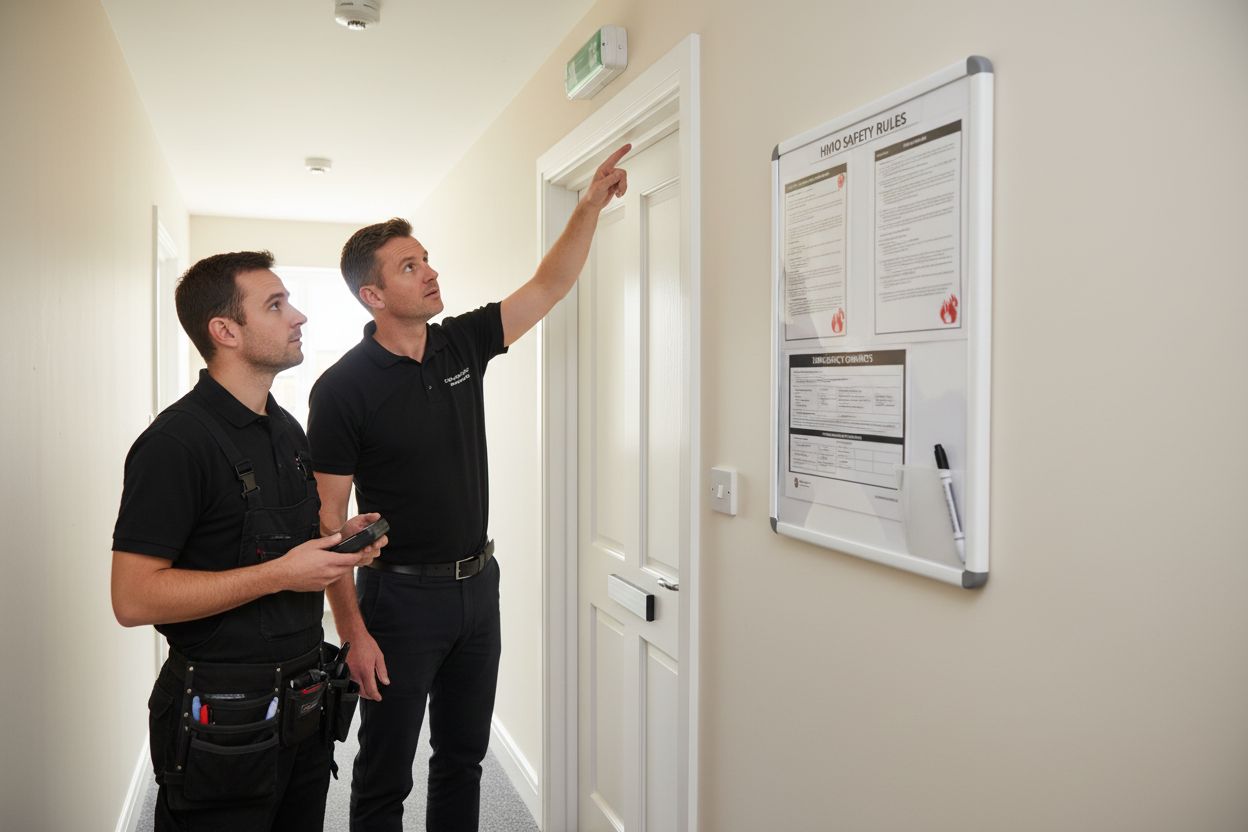Did you know that over 500,000 properties in England are registered as HMOs, housing millions of tenants under strict legal standards? The rules for managing these shared homes keep evolving each year, and the expectations in 2025 are higher than ever. Landlords and investors face new tests, more detailed safety checks, and rising penalties for non-compliance, making it critical to understand how today’s HMO regulations shape the future of multi-tenant housing.
Key Takeaways
| Point | Details |
|---|---|
| HMO Definition | A House in Multiple Occupation (HMO) requires shared amenities among tenants from different households, classified through specific legal tests. |
| Licensing Requirements | By 2025, landlords must navigate diverse licensing regulations, including mandatory applications for smaller HMOs and adherence to occupancy limits. |
| Safety Protocols | Enhanced safety standards require landlords to focus on proactive property management, including regular assessments and transparent tenant communication. |
| Compliance Consequences | Non-compliance with HMO regulations can result in significant fines, legal actions, and loss of license, necessitating meticulous adherence to guidelines. |
Defining HMOs and 2025 Regulatory Scope
A House in Multiple Occupation (HMO) represents a unique property arrangement where multiple tenants from different households share common living spaces like kitchens, bathrooms, or living areas. According to the Housing Act 2004 regulations, these properties are categorised through specific legal tests that determine their classification and subsequent regulatory requirements.
The legal definition encompasses several critical tests for HMO identification:
Here’s a summary of the primary HMO identification tests:
| Test Name | Core Criteria | Common Scenarios |
|---|---|---|
| Standard Test | Shared amenities between households | Traditional shared houses |
| Self-Contained Flat Test | Independent living units within property | Flats within a larger converted house |
| Converted Building Test | Single dwelling converted for tenants | Former large homes now multi-tenant |
- Standard Test: Involves sharing basic amenities between different household groups
- Self-Contained Flat Test: Evaluates properties with multiple independent living units
- Converted Building Test: Examines properties transformed from single-dwelling to multi-tenant configurations
Under the Housing Health and Safety Rating System (HHSRS), local authorities possess comprehensive powers to assess and mitigate potential health and safety risks within HMOs. Read more about HMO property sourcing to understand the intricate regulatory landscape that governs these multi-tenant properties. This framework, established in the Housing Act 2004, remains fundamental in 2025, providing a robust mechanism for ensuring tenant safety and property standards through mandatory licensing provisions.
The 2025 regulatory scope continues to prioritise tenant welfare, with increasing emphasis on detailed property management standards, safety compliance, and equitable living conditions across diverse multi-occupancy scenarios. Property investors and landlords must navigate these evolving regulations with precision, ensuring their HMO properties meet the stringent health, safety, and operational requirements set by local and national authorities.
Essential HMO Licensing Requirements in 2025
Navigating the HMO licensing landscape in 2025 demands a comprehensive understanding of evolving regulatory frameworks that directly impact property investors and landlords. Discover the nuanced licensing process to ensure complete compliance with the latest national and local requirements that govern multi-occupancy properties.
The licensing requirements vary significantly across different local authorities, with specific regional variations emerging. For instance, according to Southampton City Council, from 1 October 2025, a new additional licensing scheme will be implemented that requires:
- Licensing of smaller HMOs with fewer than five occupants
- Mandatory applications for properties in specific designated wards
- A strict three-month window for submitting licensing applications
Key compliance considerations for HMO licensing in 2025 include:
- Mandatory Application: Timely submission of licensing documentation
- Property Inspection: Comprehensive safety and habitability assessments
- Occupancy Limits: Strict adherence to maximum tenant capacity
- Management Standards: Demonstrating professional property management capabilities
Failure to comply with these licensing requirements can result in substantial financial penalties, potential legal actions, and restrictions on property letting. Property owners must proactively engage with local authority guidelines, maintain meticulous documentation, and ensure their HMO properties meet the increasingly stringent health, safety, and operational standards that define the 2025 regulatory environment.

Safety Standards and Habitability Protocols
Safety standards in HMO properties have undergone significant transformation, with increasingly stringent protocols designed to protect tenant welfare and property integrity. Understand critical HMO fire safety guidelines to comprehensively address the evolving regulatory landscape that demands meticulous attention to potential hazards and risk mitigation.
According to the Social Housing (Regulation) Act 2023, landlords now face more robust requirements for addressing property conditions, particularly under what’s colloquially known as ‘Awaab’s Law’. This legislation fundamentally reshapes expectations around property habitability, with specific emphasis on:
- Rapid remediation of environmental hazards
- Comprehensive damp and mould management
- Proactive maintenance of living conditions
- Transparent communication about property standards
Key safety and habitability protocols for 2025 include:
- Structural Integrity: Regular comprehensive property assessments
- Environmental Control: Advanced moisture and temperature monitoring
- Risk Mitigation: Detailed hazard identification and immediate resolution strategies
- Tenant Communication: Clear reporting mechanisms for potential safety concerns
Property owners must adopt a proactive approach, transforming safety protocols from reactive interventions to systematic, preventative management strategies. This shift requires substantial investment in property maintenance, technological monitoring systems, and a culture of continuous improvement that prioritises tenant health and safety above all other considerations.
Landlord Duties and Ongoing Compliance
The 2025 HMO regulatory landscape demands unprecedented levels of diligence and proactive management from property owners. Explore our comprehensive HMO legal checklist to ensure you remain fully compliant with the intricate requirements that govern multi-occupancy properties.
According to Southampton City Council’s licensing guidelines, HMO licences typically span five years but can be significantly shortened due to various critical factors, including:
- Management performance deficiencies
- Delays in required property modifications
- Concerns regarding landlord’s fit-and-proper status
- Unresolved safety or habitability issues
Key ongoing compliance responsibilities for landlords in 2025 encompass:
- Regular Property Assessments: Comprehensive periodic inspections
- Maintenance Documentation: Meticulous record-keeping of repairs and improvements
- Tenant Safety Protocols: Continuous monitoring of health and safety standards
- Regulatory Updates: Staying informed about evolving local and national HMO regulations
Successful HMO management in 2025 requires a holistic approach that transcends mere legal compliance. Landlords must cultivate a proactive management philosophy, investing in property maintenance, tenant relationships, and continuous professional development. This approach not only mitigates potential regulatory risks but also establishes a reputation for excellence in the competitive multi-occupancy property market.
Enforcement Actions and Penalties for Breaches
The 2025 HMO regulatory framework introduces increasingly stringent consequences for landlords who fail to comply with licensing and safety requirements. Discover critical insights into HMO legal compliance to understand the potential ramifications of regulatory breaches.
According to Southampton City Council’s licensing guidelines, non-compliance with HMO regulations can trigger a cascading series of enforcement actions, including:
- Substantial civil penalty fines
- Mandatory prosecution proceedings
- Significantly increased licensing fees
- Potential revocation of existing property licenses
Key potential enforcement mechanisms in 2025 include:
- Administrative Penalties: Financial sanctions and compliance orders
- Criminal Prosecution: Potential legal action for serious or repeated violations
- License Suspension: Temporary or permanent removal of HMO operating rights
- Reputational Damage: Public records of non-compliance affecting future property investments
Landlords must recognize that enforcement actions extend beyond immediate financial penalties. The long-term consequences can include restricted market access, diminished property values, and significant challenges in obtaining future licenses.
 Proactive compliance, thorough documentation, and a commitment to maintaining high professional standards remain the most effective strategies for avoiding these potentially devastating regulatory interventions.
Proactive compliance, thorough documentation, and a commitment to maintaining high professional standards remain the most effective strategies for avoiding these potentially devastating regulatory interventions.
Take Control of HMO Compliance in 2025 with the Right Support
Navigating HMO regulations in 2025 can feel overwhelming, especially as new licensing, safety and management standards become mandatory. Many property owners worry about missed deadlines, costly penalties or falling short of the latest compliance rules. When you are responsible for multi-occupancy property, keeping up with guides like this is only one part of the journey — you need real solutions for sourcing, managing and protecting your investments.
Access trustworthy partners, up-to-date regulatory resources, and a complete network of HMO professionals by connecting with AgentHMO’s platform. Our dedicated service directory links you with estate agents, accountants and management experts who understand every nuance of the HMO market. Make your next move more confidently. Do not risk non-compliance or stressful setbacks. Choose AgentHMO today to secure your property’s future and unlock seamless market opportunities.
Frequently Asked Questions
What is defined as a House in Multiple Occupation (HMO)?
An HMO is a property where multiple tenants from different households share common living spaces like kitchens and bathrooms. Specific legal tests, outlined in the Housing Act 2004, determine the classification of an HMO.
What are the key licensing requirements for HMOs in 2025?
In 2025, licensing requirements include mandatory applications for all HMOs regardless of the number of occupants in certain designated areas, comprehensive property inspections, and strict adherence to occupancy limits and management standards.
What are the safety standards that landlords must comply with for HMOs in 2025?
Landlords must address safety standards such as ensuring structural integrity, advanced monitoring for environmental controls, and prompt remediation of health hazards like damp and mould, following the new regulations under Awaab’s Law.
What penalties do landlords face for non-compliance with HMO regulations in 2025?
Landlords can face severe penalties for non-compliance, including substantial civil fines, prosecution, increased licensing fees, revocation of licenses, and potential reputational damage affecting future business opportunities.
Recommended
- HMO Compliance Checklist: Ensure Your Property Meets Standards
- 8 Essential Tips for Your HMO Legal Checklist 2025
- Understanding What Are HMO Regulations in Property
- HMO Fire Safety Guide: Complete UK Compliance Blueprint
- Kitchen Respray Regulations UK: Complete Guide 2025 – WordPress
- International Moving Regulations UK: 2025 Guide for Relocating | Schott Removals


